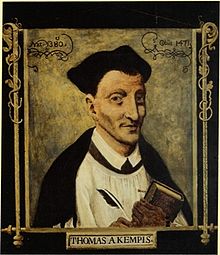Thomas a Kempis
| Thomas à Kempis, C.R.S.A. | |
|---|---|
 |
|
| Born | 1380 Kempen, Prince-Archbishopric of Cologne, Holy Roman Empire |
| Died | 25 July 1471 Zwolle, Bishopric of Utrecht, Holy Roman Empire |
| Other names | Thomas von Kempen Thomas Haemerkken Thomas Hammerlein Thomas Hemerken Thomas Hämerken |
| Occupation | Canon Regular, author, scribe |
| Known for | The Imitation of Christ |
Thomas à Kempis, C.R.S.A. (Thomas van Kempen or Thomas Hemerken or Haemerken, litt. "Hammerkin" (small hammer); c. 1380 – 25 July 1471) German born who became a canon regular of the late medieval period in the Netherlands, and the author of The Imitation of Christ, one of the most popular and best known Christian books on devotion. His name means Thomas "of Kempen", his hometown, and in German he is known as Thomas von Kempen. He also is known by various spellings of his family name: Thomas Haemerken; Thomas Hammerlein; Thomas Hemerken and Thomas Hämerken.
Thomas was born at the Lower Rhine town of Kempen, Germany, in the sovereign Prince-Archbishopric of Cologne about A.D. 1380. His surname was Hemerken, Kleverlandish for little hammer. His father John was a blacksmith and his mother Gertrude was a schoolmistress.
In 1392, Thomas followed his brother, Jan, to Deventer in the Bishopric of Utrecht, in order to attend the noted Latin school there. While attending this school, Thomas encountered the Brethren of the Common Life, followers of Gerard Groote's Modern Devotion. He attended school in Deventer from 1392 to 1399.
After leaving school, Thomas went to the nearby town of Zwolle to visit his brother again, after Jan had become the prior of the Monastery of Mount St. Agnes there. This community was one of the Canons Regular of the Congregation of Windesheim, founded by disciples of Groote in order to provide a way of life more in keeping with the norms of monastic life of the period. Thomas himself entered Mount St. Agnes in 1406. He was not ordained a priest, however, until almost a decade later. He became a prolific copyist and writer. Thomas received Holy Orders in 1413 and was made sub-prior of the monastery in 1429.
...
Wikipedia
